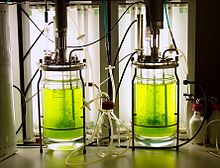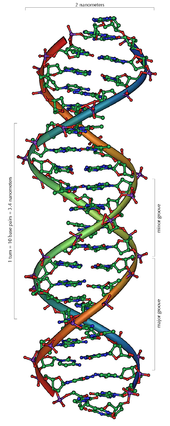Biotechnology
Biotechnology (ancient Greek βίος bíos, German 'Leben'; also synonymous with bioengineering and briefly as biotech) is an interdisciplinary science concerned with the use of enzymes, cells and whole organisms in technical applications. The aims include the development of new or more efficient processes for the production of chemical compounds and diagnostic methods.
In biotechnology, knowledge from many fields, such as above all microbiology, biochemistry (chemistry), molecular biology, genetics, bioinformatics and the engineering sciences with process engineering (bioprocess engineering) is used. Chemical reactions catalyzed by free enzymes or enzymes present in cells (biocatalysis or bioconversion) form the basis. Biotechnology makes important contributions to the process of biologization.
Classic biotechnological applications were developed thousands of years ago, such as the production of wine and beer with yeasts and the processing of milk into various foods with the aid of certain microorganisms or enzymes. Since the 19th century, modern biotechnology has made increasing use of microbiological and, since the middle of the 20th century, also molecular biological, genetic or genetic engineering findings and methods. This makes it possible to develop production processes for chemical compounds, e.g. as active ingredients for pharmaceuticals or as basic chemicals for the chemical industry, diagnostic methods, biosensors, new plant varieties and other things.
Biotechnological processes can be applied in many different areas. In some cases, attempts are made to sort these processes according to application areas, such as medicine (red biotechnology), plants or agriculture (green biotechnology) and industry (white biotechnology). In some cases, a distinction is also made according to the living organisms to which the methods are applied, such as in blue biotechnology or yellow biotechnology, which refers to applications in marine organisms or insects.

Moss Bioreactor

Thickness in cheese production
History
Biotechnological applications, such as the production of beer and wine, have existed for thousands of years. The biochemical backgrounds were initially largely unexplained. With the advances in various sciences, such as microbiology in particular in the 19th century, biotechnology was scientifically processed, i.e. biotechnology was developed. Thus, optimized or new biotechnological applications were developed. Other important steps were the discovery of deoxyribonucleic acid (DNA) in the 1950s, the increasing understanding of its importance and functioning, and the subsequent development of molecular biology and genetic engineering laboratory methods.
First biotechnological applications
The oldest applications of biotechnology, which have been known for over 5000 years, are the production of bread, wine or beer (alcoholic fermentation) with the help of yeast, which belongs to the fungi. The use of lactic acid bacteria also made it possible to produce sourdough (leavened bread) and sour milk products such as cheese, yoghurt, sour milk or kefir. One of the earliest biotechnological applications away from food was tanning and bating hides into leather using feces and other enzyme-containing materials. Large parts of biotechnology were based on these production processes until the Middle Ages, and the first biotechnological process for the production of vinegar was developed around 1650.
Development of microbiology
See also: Microbiology, Louis Pasteur and Robert Koch
Modern biotechnology is essentially based on microbiology, which emerged in the second half of the 19th century. In particular, the development of cultivation methods, pure culture and sterilisation by Louis Pasteur laid the foundations for the investigation and application (applied microbiology) of microorganisms. In 1867, Pasteur was able to isolate acetic acid bacteria and brewer's yeasts using these methods. Around 1890, he and Robert Koch developed the first vaccines based on isolated pathogens, setting the foundation for medical biotechnology. The Japanese Jōkichi Takamine was the first to isolate a single enzyme for technical use, alpha-amylase. A few years later, the German chemist Otto Röhm used animal proteases (protein-degrading enzymes) from slaughterhouse waste as detergents and auxiliary substances for leather production.
Biotechnology in the 20th century
The large-scale production of butanol and acetone by fermentation of the bacterium Clostridium acetobutylicum was described and developed in 1916 by the chemist and later Israeli President Charles Weizmann. It was the first development of white biotechnology. The process was used until the middle of the 20th century, but was subsequently replaced by the more economical petrochemical synthesis from the propene fraction of petroleum. Citric acid was produced from 1920 onwards by surface fermentation of the fungus Aspergillus niger. In 1957, the amino acid glutamic acid was produced for the first time with the aid of the soil bacterium Corynebacterium glutamicum.
In 1928/29, Alexander Fleming discovered the first medically used antibiotic penicillin in the fungus Penicillium chrysogenum. This was followed in 1943 by the antibiotic streptomycin by Selman Waksman, Albert Schatz and Elizabeth Bugie. In 1949, the production of steroids was implemented on an industrial scale. In the early 1960s, bioengineered proteases were first added to laundry detergents to remove protein stains. In cheese production, rennin produced in microorganisms has been able to replace calf rennet since 1965. From 1970 onwards, it was possible to biotechnically produce amylases and other starch-cleaving enzymes with which, for example, corn starch could be converted into high-fructose corn syrup and used as a substitute for cane sugar (sucrose), e.g. in the production of beverages.
Modern biotechnology since the 1970s
Elucidation of the DNA structure
In 1953, Francis Crick and James Watson clarified the structure and function of deoxyribonucleic acid (DNA). This laid the foundation for the development of modern genetics.
Since the 1970s, there have been a number of key developments in laboratory and analytical technology. In 1972, for example, the biologists Stanley N. Cohen and Herbert Boyer succeeded in using molecular biological methods to carry out the first in vitro recombination of DNA (modification of DNA in a test tube), as well as the production of plasmid vectors as a tool for transferring (a vector) genetic material, e.g. in bacterial cells.
César Milstein and Georges Köhler first produced monoclonal antibodies in 1975, which are an important tool in medical and biological diagnostics. Since 1977, recombinant proteins (proteins originally derived from other species) can be produced in bacteria and manufactured on a larger scale. In 1982, the first transgenic crops with genetically acquired herbicide resistance were produced, so that the corresponding herbicide spares the crop during plant protection measures. In the same year, knock-out mice were successfully produced for medical research. In these mice, at least one gene is inactivated in order to understand and study its function or the function of the homologous gene in humans.
Genome sequencing
In 1990, the Human Genome Project was launched, in which the entire human genome of 3.2 × 109 base pairs (bp) was decoded and sequenced by 2001 (or 2003 at the targeted scales). The sequencing technique is directly based on the polymerase chain reaction (PCR), developed in 1975, which allows rapid and more than 100,000-fold amplification of certain DNA sequences, thus providing sufficient quantities of this sequence, e.g. for analyses. As early as 1996, the first genome to be completely elucidated was that of baker's yeast (Saccharomyces cerevisiae) with 2 × 107 bp. The rapid development of sequencing technology enabled further genomes to be sequenced relatively quickly, such as that of the fruit fly Drosophila melanogaster (2 × 108 bp) in 1999.
The determination of genome sequences led to the establishment of further research areas based on them, such as transcriptomics, proteomics, metabolomics and systems biology, and to an increase in importance, e.g. bioinformatics.
Applications of genetic engineering
In 1995, the first transgenic product, the Flavr-Savr tomato, came onto the market and was approved for sale in the USA and Great Britain. In 1996, the first gene therapy trials were carried out in humans and in 1999, human stem cells were propagated in cell culture for the first time. In the same year, the market volume of recombinantly produced proteins in the pharmaceutical industry exceeded US$ 10 billion per year for the first time. The cloned sheepDolly was born in 1998.
The newly developed genetic engineering methods offered biotechnology new development opportunities, which led to the emergence of molecular biotechnology. It forms the interface between molecular biology and classical biotechnology. Important techniques include the transformation or transduction of bacteria with the aid of plasmids or viruses. In this process, specific genes can be introduced into suitable bacterial species. Further areas of application of molecular biotechnology are analytical methods, for example for the identification and sequencing of DNA or RNA fragments.

Structural model of a section of the DNA double helix (B-form) with 20 base pairs
.jpg)
Alexander Fleming on a stamp

Louis Pasteur was the first to isolate acetic acid bacteria and brewer's yeast.
Branches of biotechnology
Biotechnology is a very broad term. It is therefore subdivided into different branches according to the respective areas of application. In part, these overlap, so that this subdivision is not always clear. In some cases, the terms have not yet been established or are defined differently.
| Classification of biotechnology into different branches | |
| Branch | Areas of application |
| green biotechnology | Use in agriculture; plant biotechnology |
| Red biotechnology | Use in medicine and pharmaceuticals; medical biotechnology |
| White biotechnology | Use in industry; industrial biotechnology |
| Grey biotechnology | Use in waste management |
| Brown biotechnology | Technical or environmental technology, e.g. in soil protection |
| blue biotechnology | biotechnology of marine resources |
Green biotechnology concerns plant applications, e.g. for agricultural purposes. Red biotechnology is the area of medical-pharmaceutical applications, such as the production of drugs and diagnostics. White biotechnology or industrial biotechnology includes biotechnological manufacturing processes, primarily for chemical compounds in the chemical industry, but also processes in the textile or food industry.
Less common are the divisions into blue biotechnology, which deals with the use of organisms from the sea, and grey biotechnology, with biotechnological processes in the field of waste management (sewage treatment plants, decontamination of soils and the like).
Irrespective of this classification, there is the biotechnology known as the conventional form, which deals with wastewater treatment, composting and other similar applications.
Questions and Answers
Q: What is biotechnology?
A: Biotechnology is a technology that involves the use of living organisms.
Q: What are some of the main uses of biotechnology?
A: Biotechnology is mainly used in agriculture, food science, and medicine.
Q: How are living organisms used in biotechnology?
A: Living organisms are used to make useful chemicals and products or to perform an industrial task.
Q: Is biotechnology only used for medical purposes?
A: No, biotechnology is not only used for medical purposes; it can also be used in agriculture and food science.
Q: Are there any risks associated with using biotechnology?
A: Yes, there may be potential risks associated with using biotechnology, such as environmental contamination or unintended consequences from genetic engineering. It is important to consider these risks before utilizing this technology.
Q: What kind of products can be made through biotechnological processes?
A: Through biotechnological processes, useful chemicals and products can be made or tasks can be performed on an industrial scale.
Search within the encyclopedia